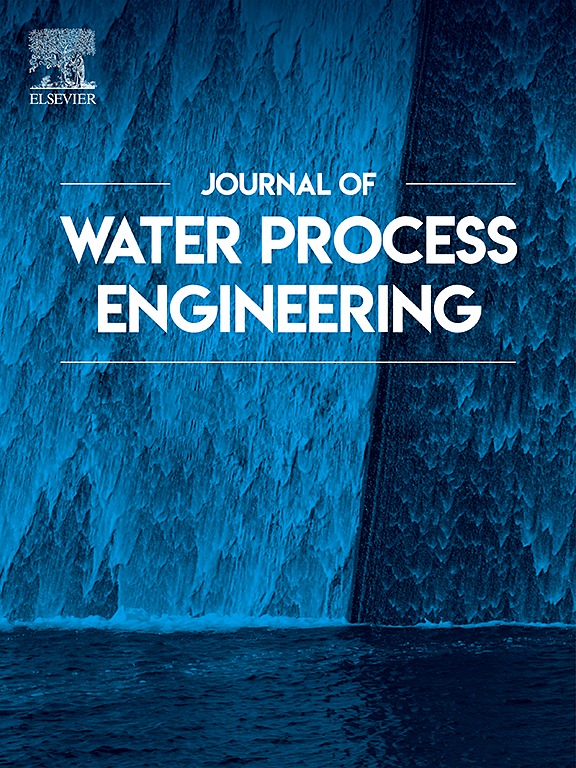Activation of peroxydisulfate by phosphoric acid-modified microwave biochar for tetracycline removal in water: Mechanistic insights
IF 6.3
2区 工程技术
Q1 ENGINEERING, CHEMICAL
引用次数: 0
Abstract
Phosphoric acid activation and microwave pyrolysis have clear benefits in biochar production. This research investigated the effects of pyrolysis power and phosphoric acid concentration on the physicochemical properties of modified biochar. The biochar with optimal activity was selected as a catalyst and used to activate peroxodisulfate (PDS) for the efficient removal of tetracycline (TC). The results revealed that the most active sample was MHP500–1500. It was prepared at a microwave power of 1500 W with 10 mol/L phosphoric acid at 500 °C. This sample had abundant active sites and excellent electron transfer capability. The specific surface area was 1508 m2/g. The MHP500–1500/PDS system achieved a TC removal rate of 92 % within 1 h. The internal graphitic carbon structure of MHP500–1500 accelerated the electron transfer in the MHP500–1500/PDS system, successfully activating PDS. PDS was adsorbed on the surface of MHP500–1500, forming a complex. The complex attacked the electron-rich pollutant TC through electron transfer, and the singlet oxygen (1O2) generated during the activation process could also attack TC. The combined action of these two non-radical pathways achieved the removal of TC. Additionally, the MHP500–1500/PDS system exhibited stability in different water environments. After five repetitions of the experiments, the removal rate of TC still reached 77 %. Compared with other carbon-based catalysts, the catalyst prepared in this study not only has a higher specific surface area but also exhibits better TC removal efficiency at a lower dosage. This study provides new insights into the non-radical pathway for pollutant removal.
磷酸修饰微波生物炭活化过硫酸氢盐去除水中四环素的机理研究
磷酸活化和微波热解在生物炭生产中具有明显的优势。研究了热解功率和磷酸浓度对改性生物炭理化性质的影响。选择活性最优的生物炭作为催化剂,活化过氧化物二磺酸盐(PDS),高效脱除四环素(TC)。结果表明,活性最高的样品为MHP500-1500。在微波功率为1500 W的条件下,用10 mol/L磷酸在500℃下制备。该样品具有丰富的活性位点和优异的电子转移能力。比表面积为1508 m2/g。MHP500-1500 /PDS体系在1小时内实现了92%的TC去除率。MHP500-1500内部石墨碳结构加速了MHP500-1500 /PDS体系中的电子转移,成功激活了PDS。PDS吸附在MHP500-1500表面,形成络合物。配合物通过电子转移攻击富电子污染物TC,激活过程中产生的单线态氧(1O2)也可以攻击TC。这两种非自由基途径的共同作用实现了TC的去除。此外,MHP500-1500 /PDS系统在不同的水环境中表现出稳定性。经过5次重复实验,TC的去除率仍达77%。与其他碳基催化剂相比,本研究制备的催化剂不仅具有更高的比表面积,而且在较低的投加量下具有更好的TC脱除效率。该研究为非自由基途径的污染物去除提供了新的见解。
本文章由计算机程序翻译,如有差异,请以英文原文为准。
求助全文
约1分钟内获得全文
求助全文
来源期刊

Journal of water process engineering
Biochemistry, Genetics and Molecular Biology-Biotechnology
CiteScore
10.70
自引率
8.60%
发文量
846
审稿时长
24 days
期刊介绍:
The Journal of Water Process Engineering aims to publish refereed, high-quality research papers with significant novelty and impact in all areas of the engineering of water and wastewater processing . Papers on advanced and novel treatment processes and technologies are particularly welcome. The Journal considers papers in areas such as nanotechnology and biotechnology applications in water, novel oxidation and separation processes, membrane processes (except those for desalination) , catalytic processes for the removal of water contaminants, sustainable processes, water reuse and recycling, water use and wastewater minimization, integrated/hybrid technology, process modeling of water treatment and novel treatment processes. Submissions on the subject of adsorbents, including standard measurements of adsorption kinetics and equilibrium will only be considered if there is a genuine case for novelty and contribution, for example highly novel, sustainable adsorbents and their use: papers on activated carbon-type materials derived from natural matter, or surfactant-modified clays and related minerals, would not fulfil this criterion. The Journal particularly welcomes contributions involving environmentally, economically and socially sustainable technology for water treatment, including those which are energy-efficient, with minimal or no chemical consumption, and capable of water recycling and reuse that minimizes the direct disposal of wastewater to the aquatic environment. Papers that describe novel ideas for solving issues related to water quality and availability are also welcome, as are those that show the transfer of techniques from other disciplines. The Journal will consider papers dealing with processes for various water matrices including drinking water (except desalination), domestic, urban and industrial wastewaters, in addition to their residues. It is expected that the journal will be of particular relevance to chemical and process engineers working in the field. The Journal welcomes Full Text papers, Short Communications, State-of-the-Art Reviews and Letters to Editors and Case Studies
 求助内容:
求助内容: 应助结果提醒方式:
应助结果提醒方式:


